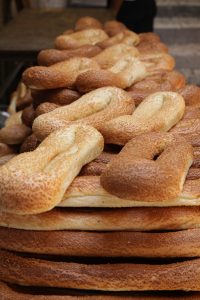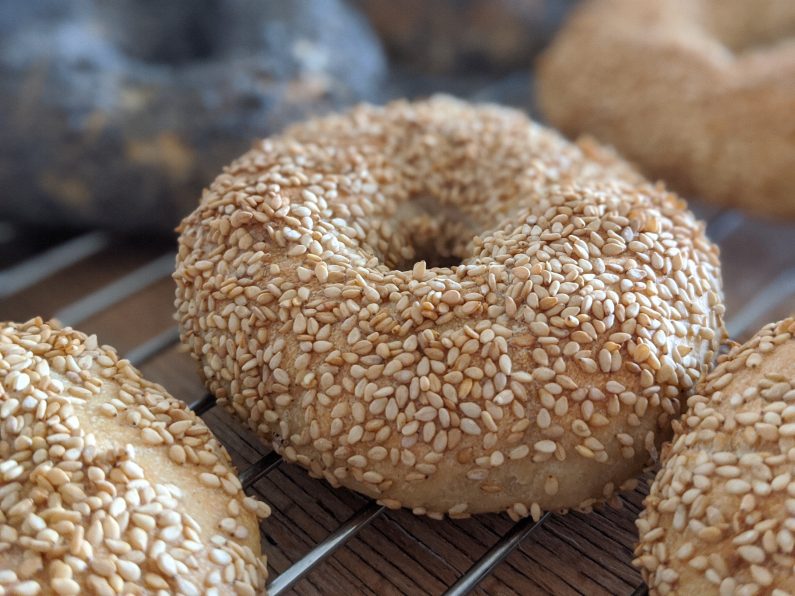If you spend time reading on the Internet about food history or Middle Eastern cuisine, chances are you recently saw a post by Palestinian-American cookbook author Reem Kassis in which she claimed that the bagel has origins in the Arab kitchen. I first came across it when my friend Sarah forwarded me an article from Serious Eats in which Ms. Kassis lays out her argument. Sarah wanted to know my thoughts on the article.
I read it and found it interesting, but flawed, and I explained to her in my response the problems I saw with the claim. And then I forgot about it.
Only after seeing the claim pop up elsewhere (and in a place with a more sizable audience), as part of the promotion for Ms. Kassis’ new book, did I decide that this post might be necessary. First, I know that if I have now seen the claim in two locations, I will almost certainly see it in more — such is the nature of book promotion. Numerous interviews are sure to follow, and this will be one of the main talking points to be repeated and explored.
Beyond that, I also know how such things work in the world of social media. What started as an interesting observation about a historical curiosity first developed into a speculation about what actually happened, and this speculation (via repetition) would soon become quoted as fact. If you don’t believe me, simply read the comments on the Serious Eats post; many commenters clearly assume that Ms. Kassis’ speculation is actually indisputable fact. I’m sure it will not be long before you see the article linked in the Wikipedia article about bagels. (And I fear that by mentioning that, I’ve encouraged someone to do that at this very moment.)
So I write this in the hopes that anyone who searches will at least also find this response, and consider it with equal weight. When I say this, I also recognize the unlikelihood that will happen, due to the highly politicized topic this post addresses. Rather than looking at the opposing arguments that I and Ms. Kassis each make, many will simply look at our respective identities: she a Palestinian Arab who moved to the United States, I an American Jew who moved to Israel. So many will look less at the substance of our articles, and simply choose to believe the one that lines up with their preconceived view of the Israeli-Palestinian relationship. Frankly, and I know this is a somewhat controversial opinion, I do not believe politics has a place in a conversation about food. To me, food is actually the least political thing there is, and politics only relate to it when it is actively weaponized for political purposes.
You need not agree with that opinion, however, to consider this response with honesty. And I am not saying that Ms. Kassis herself was attempting to politicize the history of the bagel in the article she wrote. I have not had the pleasure of meeting Ms. Kassis (and I’m certain it would be a pleasure to speak with her about our shared love of food). Thus, I make absolutely zero speculations about any potential motivations or ulterior motives for her making her claims. I respect her knowledge and research. It is simply my hope that people will look past their own politics and more at the claims and support themselves.
A Summary of Kassis’ Claim
The main points of Ms. Kassis’ article are as follows (and please read the whole article for greater depth). She begins by discussing Ka’ak al-Quds, commonly referred to as a Jerusalem Bagel, a food that she knows from growing up and that I and anyone who visits Jerusalem knows quite well. She then mentions that in the 13th-century Arab cookbook Kitab al-Wusla ila l-habib fi wasf il-tayyibat wa-al-tib (probably compiled in Syria), among numerous recipes for ka’ak, one mentions boiling the ring shaped dough before baking it. Suddenly she realized there might actually be a historical connection, in which the medieval Arab bread (it is also mentioned previously in the 10th-century Kitab al-Tabikh) actually was a precursor that led to the creation of the bagel as we know it.

As support, she points to the fact that bagels are made with wheat, which was less common in Poland (where rye was a more commonly consumed flour for bread) than in Italy. Also, she highlights other bagel-like breads in different areas where there was Muslim and Arab spheres of influence, among the Uigurs of northwestern China and in Turkey.
The fact that many of these breads (including the ka’ak al-Quds) are not boiled, and other distinctions between them, Kassis sees as actually what ties them together. She sees them all as “examples of culinary fusion, which is as old as cuisine itself. Centuries of conquest, migration, and trade have allowed culinary traditions to meld and evolve, both naturally and by force.” Rather than seeing the differences between these different breads as suggesting different origins, Kassis claims that “the most relevant insight of the journey of this ring-shaped bread through history is that it isn’t uncommon for people to adopt the foods of those they interact with and to evolve those foods in unique ways.”
Finally, Kassis ends her article with a plea that we “learn of and honor the inspiration behind the bagel to begin with.” She states that recognizing this in no way detracts from “the bagel’s celebrated position in American Jewish cuisine or its own unique history.” Rather she sees the bagel as a food that reflects the intertwined food cultures of the world, not that divides us.
So to summarize, Ms. Kassis makes the following points:
- al-Wusla in the 13th century mentions one type of ka’ak (among others) that is boiled and then baked. Ka’ak itself is commonly eaten and known, at least as far back as the 10th century.
- The precursor of the bagel came to Poland from southern Italy, and suggests the influence of Arab cuisine.
- This is supported by the use of wheat, rather than rye flour.
- Numerous other similar-looking breads also appear at points of contact with the Muslim world, underscoring this possibility.
- The distinctions between these breads and the bagel reinforce the continuity of influence between the boiled/baked ka’ak and the bagel of Eastern Europe.
- Emphasizing these Arab origins for the bagel does not detract from its significance to other cultures, rather underscoring the degree to which our cultures are connected.
My Response

Let me now address the other 5 points in sequence. Regarding al-Wusla’s ka’ak recipe, I have no direct objection. Just a question. I am quite certain that Ms. Kassis is more knowledgeable on the topic than I am, and would thus not dream of “mansplaining” what al-Wusla actually was talking about (seriously). And though I have not read the entire book (in translation or otherwise), I have read segments excerpted in a few other books. I did not come across the version of ka’ak that she mentions, so I would love to see the text so I can better put it in context to understand it, and to see how that version relates to the other ones that are not first boiled. (I did find a reference in one of the medieval Arab cookbooks in translation to boiling ka’ak in oil, however.)
My question, however, stems from the fact that ka’ak historically(1)Annals of the Caliphs’ Kitchens: Ibn Sayyar al-Warraq’s Tenth-Century Baghdadi Cookbook: English Translation with Introduction and Glossary, Nawal Nasrallah and today(2)Sweet Middle East: Classic Recipes from Baklava to Fig Ice Cream, Anissa Helou; The Oxford Companion to Food, Third Edition, ed. Tom Jaine, through much of the Arab world, refers not to a bread at all, but to a small, hard, savory cookie. The application of the name to a soft bread, such as the ka’ak al-Quds, would seem to be a later adaptation of the name. So the question is whether or not al-Wusla’s reference is even to a bread at all! Without seeing the reference, I am not claiming it is not, but the question remains a significant one, at least for now.
Point 2, about the Italian source for bagels, is in fact the strongest objection I have. As support for her claim, Ms. Kassis points to Maria Balinska’s work. Unfortunately, Balinska herself rejects this connection after first raising it. She first highlights the point that obwarzanek were being made in Krakow for over a hundred years before Queen Bona’s arrival there (a point that Kassis also mentions, but oddly fails to explain). Then on the next page she proffers an alternative (and to her preferable) source: “It is likely that the obwarzanek (which is also referred to in Polish documents by the Latin world circulis) reached Poland via Germany.”(3)The Bagel: The Surprising History of a Modest Bread, Maria Balinska, p. 14-15
Germany had no history of Arab conquest or rule, and also was always firmly outside the Arab and Muslim sphere of influence. The German precursor to the obwarzanek and bagel is the pretzel (made of a similarly wheaten dough, by the way). We know of streams of immigrants from Germany into Poland, and that the pretzel was much older, and it is, of course, also boiled before baking. Even if this is disproven as a source for some unknown (so far) reason, the presence of the pretzel as an older, wheaten, boiled-then-baked bread indicates what should be obvious already: similar culinary innovations frequently occur in different parts of the world. (Balinska also points out, by the way, a Roman precursor to the Arab ka’ak, and that it appears in numerous ancient sources, including the Talmud.) Without showing with certainty that the Italian ciambella brought the innovation of one specific type of Arab ka’ak up to Poland where it grew into the bagel, the more plausible connection between the German pretzel and the bagel and obwarzanek must be accepted. And at the very least, we must not suggest that the person who did the research (Balinska) agreed with the Italian hypothesis when she actually flat-out rejected it.
Balinska also provides the answer to Point 3. Not only was did the pretzel have its origins as a bread for Lent, but so did the obwarzanek. It was first made for Polish Queen Jadwiga, a particularly pious woman, but she remained a queen with the associated wealth. Thus, “In an area of Europe where rye was the dominant grain, this [using wheat flour] made the obwarzanek a luxury food despite its association with abstinence. It was, in other words, a Lenten bread fit for the royal table.”

Which brings me to Point 5. Clearly the biggest distinction between ka’ak al-Quds and bagels is the fact that bagels are boiled first and ka’ak al-Quds is not. Uigur Girde naan, by the way, is not boiled either. Rather than seeing this as a flaw in the Ka’ak-to-bagel-influence argument, Ms. Kassis frames it almost as proof. She sees the baking of ka’ak without a pre-boil as an innovation despite the continuity she claims between ka’ak and bagels. Frankly, this is the weakest part of her argument. The idea of baking bread goes back to ancient times, long before anyone ever thought to boil a dough and then bake it. Thus, the innovation was to be found in all of the cases where a people chose to boil a dough first. The fact that today’s ka’ak al-Quds is not boiled first is not the result of innovation to the prior boiled-then-baked version of the ka’ak. It is the continuity with all the other versions of ka’ak, and all other breads of the world!
By making this claim about the different preparation methods, combined with the other points above, Ms. Kassis’ argument goes as follows: There were many types of ka’ak in the medieval Arab world, one of which was boiled and then baked. That one version (for which we find no further reference in any other Arab source before, contemporaneously or later) was brought via Italy to Poland. It somehow reached there a century before the woman who allegedly brought it, influenced the populace, and led to the creation of the bagel, despite a more plausible source for the bread coming via Germany. Furthermore, that same boiled-then-baked ka’ak continued forward in the Arab world, and some innovators came up with the idea to stop boiling it first, leading both to other unboiled breads in different regions and to the oval roll that Ms. Kassis knew from growing up.
Respectfully, Ms. Kassis, I appreciate the curious observation you raise (and for bringing to my attention and that of others the potential existence of yet another world bread that was boiled before it was baked). But due to the above arguments, in the absence of any further supporting evidence, I can’t accept the claim that ka’ak was the influencing precursor to the bagel, or even that it represents “one distinctive branch in the evolution” of the bagel, as anything more than intriguing speculation.
(All photos in this post were taken from Wikimedia Commons.)
Footnotes
| ↑1 | Annals of the Caliphs’ Kitchens: Ibn Sayyar al-Warraq’s Tenth-Century Baghdadi Cookbook: English Translation with Introduction and Glossary, Nawal Nasrallah |
|---|---|
| ↑2 | Sweet Middle East: Classic Recipes from Baklava to Fig Ice Cream, Anissa Helou; The Oxford Companion to Food, Third Edition, ed. Tom Jaine |
| ↑3 | The Bagel: The Surprising History of a Modest Bread, Maria Balinska, p. 14-15 |
| ↑4 | Jewish Merchant Adventurers: A Study of the Radanites, Louis Rabinowitz |







anna
the culture of appropriation has taken over the culinary world. when all you have is HUMUS and BAGELS? what next, Einstein was a Palestinian, Al Bert Ein Stein?